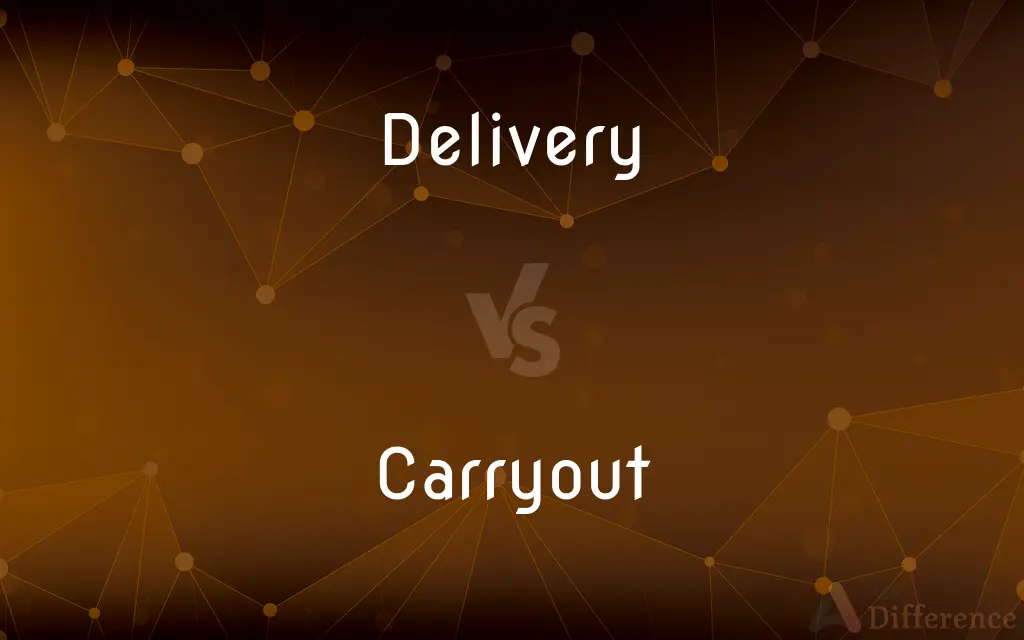Delivery vs. Carryout — What's the Difference?
Edited by Tayyaba Rehman — By Fiza Rafique — Updated on March 22, 2024
Delivery involves sending goods to a customer's location, focusing on convenience and service. Carryout requires customers to pick up their orders themselves, emphasizing immediacy and often cost savings.

Difference Between Delivery and Carryout
Table of Contents
ADVERTISEMENT
Key Differences
Delivery services provide the convenience of having products, especially food, sent directly to one’s doorstep, eliminating the need for travel. Whereas carryout services require individuals to physically go to the store or restaurant to collect their items, which can be quicker for the customer and reduces the business's delivery logistics.
Delivery often includes additional fees or higher prices to cover the cost of transportation and delivery personnel. On the other hand, carryout orders might come with discounts or no extra charges, making them financially more attractive for customers not willing to pay for delivery convenience.
The delivery process can be influenced by external factors such as traffic, weather, and distance, potentially delaying the arrival of the goods. Carryout, however, allows customers to control the retrieval time of their order, provided they are punctual, minimizing the risk of such delays.
Businesses offering delivery services must invest in a reliable delivery system, which includes vehicles, drivers, and technology for tracking and managing orders. In contrast, carryout services primarily require an efficient in-store system for preparing orders and handling pickups, demanding less logistical complexity.
Customers who prefer minimal contact, especially during health crises, may opt for delivery services to reduce exposure. Meanwhile, carryout can offer a faster, more controlled experience for those willing to venture outside, with some establishments even providing curbside pickup to blend convenience with safety.
ADVERTISEMENT
Comparison Chart
Primary Benefit
Convenience and service
Immediacy and potential cost savings
Customer Effort
Minimal, as goods are received at the door
Requires traveling to and from the location
Cost
Often higher, includes delivery fees
Usually lower, may have pickup discounts
Time Reliability
Subject to external delays
More controlled by the customer
Logistics Required
Comprehensive delivery system
Efficient in-store preparation and pickup
Compare with Definitions
Delivery
The process of sending out goods for direct handoff to customers.
Online retailers specialize in fast delivery of a wide range of products.
Carryout
The act of picking up and transporting items oneself.
Carryout options allow you to grab coffee on the go.
Delivery
The act of handing over an item or message.
Courier services ensure secure delivery of important documents.
Carryout
A service model where customers collect their orders in person.
Carryout pizza specials are popular for quick, convenient meals.
Delivery
A service where goods are transported to the customer's location.
Pizza delivery services bring your order right to your doorstep.
Carryout
The practice of retrieving purchases directly from a vendor.
Local bakeries offer carryout for fresh bread and pastries.
Delivery
A mechanism for distributing products from a central point.
Food delivery apps facilitate meals from various restaurants.
Carryout
A transaction where goods are handed over for immediate take-away.
Many fast-food restaurants have streamlined their carryout processes.
Delivery
A method of transaction completion where the seller sends items to a buyer.
Furniture stores often offer delivery options for large items.
Carryout
A method preferred for its immediacy and simplicity.
Carryout meals can be the perfect solution for a last-minute dinner.
Delivery
The act of conveying or delivering.
Carryout
Food that is intended to be eaten outside the establishment from which it is bought.
Delivery
Something delivered, as a shipment or package.
Carryout
An establishment that prepares and sells food to be taken away on demand; a takeaway.
Delivery
The act of transferring to another.
Delivery
(Law) A formal act of transferring ownership of property to another
Delivery of a deed.
Delivery
The act of giving up; surrender.
Delivery
The act or manner of throwing or discharging.
Delivery
The act of giving birth; parturition.
Delivery
Utterance or enunciation
The historic speech required but two minutes in delivery.
Delivery
The act or manner of speaking or singing
A folk singer's casual delivery.
Delivery
The act of releasing or rescuing.
Delivery
The act of conveying something.
The delivery was completed by four.
Delivery of a nuclear missile to its target
Delivery
The item which has been conveyed.
Your delivery is on the table.
Delivery
The act of giving birth
The delivery was painful.
Delivery
(baseball) A pitching motion.
His delivery has a catch in it.
Delivery
(baseball) A thrown pitch.
Here is the delivery; ... strike three!
Delivery
The manner of speaking.
The actor's delivery was flawless.
Delivery
(medicine) The administration of a drug.
Drug delivery system
Delivery
(cricket) A ball bowled.
Delivery
(curling) The process of throwing a stone.
Delivery
(genetics) Process of introducing foreign DNA into host cells.
Delivery
(football) A cross or pass
Delivery
The act of delivering from restraint; rescue; release; liberation; as, the delivery of a captive from his dungeon.
Delivery
The act of delivering up or over; surrender; transfer of the body or substance of a thing; distribution; as, the delivery of a fort, of hostages, of a criminal, of goods, of letters.
Delivery
The act or style of utterance; manner of speaking; as, a good delivery; a clear delivery.
Delivery
The act of giving birth; parturition; the expulsion or extraction of a fetus and its membranes.
Delivery
The act of exerting one's strength or limbs.
Neater limbs and freer delivery.
Delivery
The act or manner of delivering a ball; as, the pitcher has a swift delivery.
Delivery
The act of delivering or distributing something (as goods or mail);
His reluctant delivery of bad news
Delivery
The event of giving birth;
She had a difficult delivery
Delivery
Your characteristic style or manner of expressing yourself orally;
His manner of speaking was quite abrupt
Her speech was barren of southernisms
I detected a slight accent in his speech
Delivery
The voluntary transfer of something (title or possession) from one party to another
Delivery
(baseball) the throwing of a baseball by a pitcher to a batter
Delivery
Recovery or preservation from loss or danger;
Work is the deliverance of mankind
A surgeon's job is the saving of lives
Delivery
The act of delivering a child
Common Curiosities
Which is more convenient, delivery or carryout?
Delivery is generally more convenient as it requires minimal effort from the customer, whereas carryout necessitates traveling to the store.
Are there additional fees associated with delivery services?
Yes, delivery services often include additional fees to cover the cost of transport and labor.
Do restaurants offer both delivery and carryout options?
Many restaurants offer both options, catering to the preferences and needs of different customers.
Which service is better during a health crisis?
Delivery is often preferred during health crises for its minimal contact, though carryout with proper safety measures can also be safe.
How do weather conditions affect delivery and carryout services?
Weather can significantly delay delivery services, while carryout might only be affected by the customer's ability to travel.
What is carryout?
Carryout refers to a service where customers pick up their orders directly from the business premises.
Is carryout cheaper than delivery?
Typically, carryout is cheaper as it avoids delivery fees and may include discounts for picking up in person.
Can carryout orders be faster than delivery?
Yes, carryout orders can be faster, as they are not subject to delivery route delays and depend on the customer's timing.
Which service is better for large orders?
Delivery is often more convenient for large orders, especially if transporting the items would be difficult for the customer.
What is delivery?
Delivery is the process of transporting goods from a business to the customer's specified location.
Is tipping customary for delivery and carryout?
Tipping is customary for delivery to compensate for the delivery personnel's effort and vehicle use, while it is less expected for carryout.
How do businesses prepare for delivery services?
Businesses need to invest in a delivery infrastructure, including vehicles, drivers, and order tracking systems.
Can carryout orders help reduce environmental impact?
Carryout orders can reduce the environmental impact by eliminating the need for delivery vehicles, assuming the customer uses eco-friendly transportation methods.
Can I track my delivery order?
Yes, many delivery services offer tracking options so customers can monitor their order’s progress.
Do I need to call ahead for carryout?
While not always necessary, calling ahead for carryout can reduce wait times and ensure order accuracy.
Share Your Discovery

Previous Comparison
Revitalise vs. Revitalize
Next Comparison
Equivocal vs. EquivocallyAuthor Spotlight
Written by
Fiza RafiqueFiza Rafique is a skilled content writer at AskDifference.com, where she meticulously refines and enhances written pieces. Drawing from her vast editorial expertise, Fiza ensures clarity, accuracy, and precision in every article. Passionate about language, she continually seeks to elevate the quality of content for readers worldwide.
Edited by
Tayyaba RehmanTayyaba Rehman is a distinguished writer, currently serving as a primary contributor to askdifference.com. As a researcher in semantics and etymology, Tayyaba's passion for the complexity of languages and their distinctions has found a perfect home on the platform. Tayyaba delves into the intricacies of language, distinguishing between commonly confused words and phrases, thereby providing clarity for readers worldwide.














































